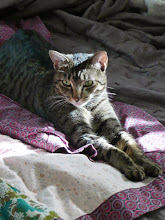Perfect Fit: The
Pocket Beagle in History
For a dog
with a sweet voice, big heart, and purely portable size, hunters of times past looked
no further than the pocket beagle. This
compact version of the standard beagle kept intact all the smarts and strength
of the breed in a package with its own winsomeness.
Beagles may
have gotten their name from the Celtic word for small, “beag.” An old breed, these dogs have been known in
England since medieval times, possibly as far back as the reign of Edward II, who
was said to have his own pack of small beagles.
The best known royal aficionado of the size was Queen Elizabeth I, whose
beagles were reported to be as small as nine inches, and fit in the wide
gauntlets worn at the time. These
“glove” beagles also became known as “pocket” beagles, as they fit just as
easily into a saddlebag or other purse-like accessory in the days when pockets
were tied on to one’s outfit. Other
descriptions were “sleeve” or “toy,” and the high sweetness of their voices led
Queen Elizabeth to call them her “singing beagles.” However, a 1911 British sport encyclopedia
states that all these terms are incorrect, the only correct one being “rabbit
beagle,” adding that Prince Albert ran a pack of them that were very small and
pure white.
William III
of Britain
hunted with pocket beagles; George IV, while still Prince of Wales, kept a pack
reputed to run with unusual speed. The
Marquis of Linlithgow was reported to have a fine kennel of “these little
creatures, which display extraordinary fire, spirit, and dash,” in 1903 (this
from H.A. Bryden, in Hare-hunting and
Harriers). In 1818 a sports writer
had this contrary opinion: “The Little Beagle, the smallest of
Hounds, which may be carried in a man's glove, is bred
for delight only, being of curious scent and passing cunning in the
hunt, for the most part tiring, and seldom killing the prey, but at some
strange advantage.”
For a last
word on the affection and respect inspired over the years by these tiny
powerhouses, let’s revisit a passage found in the Report of the Beagle Club of
1902, as reported by Herbert Compton of London
in his compendium The Twentieth Century
Dog:
Pocket beagles. The smaller a
perfect specimen can be obtained, the more valuable it is, for the great
difficulty is to preserve the characteristics of a good hound,—the straight
legs, short back, and powerful loins,—in such an exceedingly small compass, for
the outside limit of height allowed is 10 inches. Under certain circumstances a
pack of pocket beagles is invaluable. If you are not so young as you
were, if your health is doubtful, if you love to see hounds hunting but care
little about the actual kill, then nothing can be better. . . Some of these
little packs are as keen as mustard, and afford untold pleasure and interest.
A brave
hunter and friend, the pocket beagle clearly provided stout-hearted
companionship in a small package over the centuries. Doesn’t that make your own little dog look
pretty big to you right now?


1 comment:
Do they still exist as a breed?
Interesting article.
Post a Comment